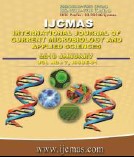


 National Academy of Agricultural Sciences (NAAS)
National Academy of Agricultural Sciences (NAAS)

|
PRINT ISSN : 2319-7692
Online ISSN : 2319-7706 Issues : 12 per year Publisher : Excellent Publishers Email : editorijcmas@gmail.com / submit@ijcmas.com Editor-in-chief: Dr.M.Prakash Index Copernicus ICV 2018: 95.39 NAAS RATING 2020: 5.38 |
Field experiments were conducted at Krishi Vigyan Kendra, Veterinary College and Research Institute, Namakkal during winter irrigated season of 2015- 2016 and 2016-2017 to study the different fertilizer levels in Bt cotton based annual legume fodder intercropping systems. The treatments comprised of intercropping systems in the main plot (C1- Bt cotton alone; C2- Bt cotton + fodder cowpea; C3-Bt cotton + horse gram; C4- Bt cotton + moth bean; C5-Bt cotton + pillipesera) and different fertilizer levels in sub plot (F1-100% RDF; F2- 125% RDF; F3-150% RDF). The experiments were laid out in split plot design with three replications. Among the different intercrops studied, fodder cowpea recorded significantly higher growth attributes like plant height, LAI, DMP and CGR and green fodder yield as compared to horse gram, moth bean and pillipesera. Among three different fertilizer levels, significantly higher growth characters and green fodder yield were obtained by application of 150% RDF (F3) followed by 125% RDF (F2). Bt cotton + mothbean (C4) had harvested higher solar energy at all the stages of crop growth than other intercropping system. Bt cotton + fodder cowpea (C2) recorded higher number of root nodules, compared to other intercropping systems which recorded at 55 DAS during both the years. Application of 150% RDF intercepted more solar radiation followed by 125% RDF during important growth stages of the crop. Quality characters of green fodders viz., crude protein, crude fibre ether extract and total ash were not significantly influenced by the intercropping system and different fertilizer levels during both the years. Higher crude protein (5.67 and 4.65 per cent) and total ash content (4.98 and 4.61 per cent) in green fodder was recorded in mothbean (C4) during both the years. However, higher crude fibre (7.26 and 6.55 per cent) content was noted in horse gram (C3) and fat content of 0.88 and 0.81 per cent was observed in fodder cowpea (C2) during both the years.
 |
 |
 |
 |
 |